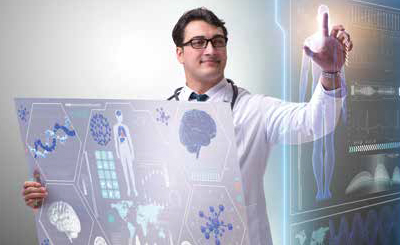Digital transformation in Healthcare, through data and artificial intelligence (AI) solutions, is the way to overcome the significant challenges the healthcare services are facing across the globe. Despite substantial healthcare data, fragmentation limits its utility. AI can unlock its potential, aiding diagnostics, treatment, and patient care. Unified patient data platforms and AI-driven insights can improve healthcare accuracy, personalised treatment, and patient monitoring.

Health is, most probably, the number one priority when we think about ourselves, our families, friends and our loved ones. It’s widely agreed that healthcare services, with the different models available across the globe, need to serve people in an effective and efficient way, to give us the best healthcare possible. But what does ‘the best healthcare possible’ really mean? If we try to ground this to more specific targets, ‘the best healthcare possible’ is about keeping us healthy for as long as possible, and to have a quick and treatment fast and promptly, to get timely interventions, and to have convenient and sufficient follow-ups to ensure the right patient progress whenever a potential health issue appears.
However, everywhere in the world healthcare services are facing major challenges preventing them to accomplish these objectives successfully:
Under these conditions, the only way to overcome challenges and improve the outcomes of our healthcare services is to elevate its effectiveness and efficiency through digital transformation and the adoption of Digital Health solutions within healthcare organisations.

Digital transformation in healthcare has been a subject of discussion for the past 15 years. However, the adoption of digital technologies within the sector remained sluggish until the arrival of the COVID-19 pandemic. The pandemic accelerated the urgency to transform healthcare delivery methods and redefine the relationships between citizens, healthcare professionals, and healthcare organisations.
Nevertheless, substantial room for improvement remains in terms of digital transformation to significantly enhance healthcare services. One of the most promising areas is data and AI, and their benefits for patients, professionals and public and private healthcare institutions. In the realm of digital transformation, data takes centre stage, holding the promise of significant opportunities, with AI as the necessary tool to unlock the outcomes and value from this data.
Healthcare data is expanding rapidly, generating around 50 petabytes annually for an average-sized hospital and growing at a rate close to 50 per cent per year. The potential value of the data is enormous, although we are still at the beginning of the journey to see it in action. As a reference, the European Commission estimated the value of using the healthcare data for patients’ benefits at €5.2 billion for the UK’s NHS alone.
Despite these impressive figures, the reality is that healthcare data today remains siloed, disconnected, fragmented and unstructured. Various systems store the information in separate repositories, using different patient identifiers and codes, which obstructs the possibility of creating a unified and cohesive patient view. Healthcare professionals spend a significant amount of time and effort to populate information systems with patients’ data, but over 90 per cent of this data is never used again or generates value back to the professionals. Moreover, approximately 80 per cent of the healthcare data is unstructured , therefore not usable for analysis and processing, unless dedicating a huge amount of manual effort from the healthcare professionals.
While electronic health records (EHRs/EMRs) serve as the primary repository for patient information, crucial data resides in systems like image diagnostic systems, laboratory information systems, pathology information systems, and genomic repositories.
Unfortunately, these systems often operate in isolation, not connected between each other, preventing a comprehensive overview of patients' health information. This isolation extends to information sharing between hospitals, healthcare providers, and public and private entities. Hospitals, healthcare providers and public and private entities, rarely share and interconnect their information, ending in disconnected repositories across the different entities and disjointed information between different providers, hospitals and organisations.
Additionally, not all the relevant information resides in the healthcare information systems (HIS). Often, there is crucial information that only the patient possesses. For example, a diabetes patients’ life habits are key: nutrition, physical activity, insulin injections etc. This information is only available through wearables and apps used by the patient, which today are not present in the HIS and, in general, not available for healthcare professionals.
The potential for leveraging data in the realm of digital health is immense. Creating unified patient information repositories requires connecting data across disparate systems. This entails applying natural language processing to extract and structure information from PDF reports and free-text fields, as well as using advanced processing techniques for diagnostic images, pathology results, genomics data, and wearable device information. Master patient index solutions are also crucial for consolidating patient information across systems with differing identifiers and codes.
By creating a consolidated view of patient information, healthcare professionals gain quick access to relevant data, enabling informed decisions. For example, a professional could refrain from prescribing a contrast-enhanced CT exam if the patient has a history of radiotherapy and chemotherapy, and recent lab results show high creatinine levels indicating potential risk for the kidney if contrast dose is prescribed.
Today, this critical task of gathering and consolidating patients’ information, is done by healthcare professionals, often requiring them to manually access multiple systems and applications looking for the information needed. In the best case, this consumes tons of time and effort from the professionals, which is directly impacting their capacity to attend to more patients. In the worst case, professionals could be missing relevant information, and making suboptimal decisions for patients. Creating unified patients’ data platforms which automatically show all the relevant data to the healthcare professionals, will not only help to improve decision-making accuracy, but also reduce professionals’ time spent digging through diverse systems to find the right information and will improve their capacity to attend more patients with enhanced care.
This holistic view of patient’s information, needs to be the foundational backbone for patient and disease management, and will enable what we call ‘Data-driven healthcare’ with advanced solutions and applications, including:
AI is on everyone’s lips these days, and no doubt, healthcare is one of the sectors where it can have a very significant positive impact. AI has swiftly emerged as a transformative force within the healthcare sector, revolutionising medical services, diagnostics, treatment and intervention decisions and management. With its ability to analyse vast amounts of data and extract valuable insights, AI has already demonstrated remarkable successes. However, it also faces its fair share of challenges and barriers. AI and data are intrinsically related. To develop, validate and get outcomes from AI, vast volumes of data are needed with the right characteristics, quality and variety. At the same time, to be able to process, analyse, and get the right insights from the data, traditional techniques are not enough.
AI in healthcare has multiple use cases, and the specific techniques, algorithms and maturity vary. Analysing research studies published in PubMed , the areas with a faster development are radiology, pathology, surgery, oncology and mental health. This indicates what’s coming to real medical practice in the near future. But when it comes to realities today, we need to have a look at what the US Food & Drug Administration (FDA) has approved for clinical use, where the areas most developed are Radiology , Cardiology and Oncology.
Some of the most significant outcomes AI can bring to healthcare delivery can be summarised as follows:
AI in healthcare is a reality today, and not as a potential future technology., The benefits it can bring leaves no other option rather than embrace it to build better, faster and more sustainable healthcare services.
Nevertheless, we cannot ignore the barriers and challenges we are facing: regulatory certifications, data privacy and security, bias and ethics, physicians adoption and training are only some of the challenges that need to be treated with maximum care and rigour.
Data and AI have the potential to reshape healthcare in remarkable ways; from improving diagnostics and treatment to enhancing patient outcomes and operational efficiency. While success stories are already there, we are still in the very beginning of this journey and challenges and barriers cannot be underestimated. As the industry continues to harness the power of data and AI, collaboration among healthcare professionals, technologists, regulators, and patients will be key to overcoming challenges and unlocking the full potential of a new era of data-driven healthcare. With careful navigation and innovation, the transformative influence on healthcare is poised to create a brighter, more efficient, and patient-centric future.